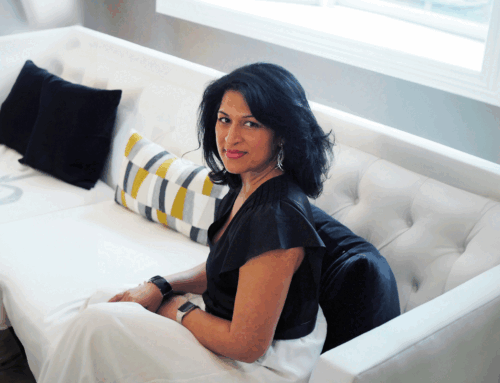Writing by Aerin Atinsky
Artwork by Jimmy Sheehan
“Ifelt like I was stranded in the middle of the ocean with no one coming to help me,” says 11-year-old Katonah resident Addie Black.
When Black was in first grade at her local elementary school, she was struggling to read. She began receiving extra help during what the school called WIN Time (“What I Need”) while her classmates enjoyed what she says was a free period.
Eventually, Black was diagnosed with dyslexia and her family concluded that her school could not adequately teach her how to read. In third grade, Black transferred to The Windward School, an independent school for children with dyslexia and other language-based learning disabilities.
“That was very hard for me to accept – stepping into a new territory was scary,” Black remembers.
Not only was she diving into an unfamiliar environment, but what used to be a 10-minute drive to school turned into upwards of 45 minutes, requiring her to wake up at 6:00 a.m., whereas she previously slept until 8:00 a.m. Black isn’t alone in this struggle.
“There are a lot of days we’re fighting for seats,” she says. “Everyone has to either double up or triple up on the bus.”
This bus is full of kids from only her school district – other districts throughout the county have their own buses of students driving to and from Windward and similar schools.
These students’ learning disorders have, they would say, forced them to attend Windward, but many families and experts say a solution exists that would allow most of them to remain learning alongside their peers in their local schools. Moreover, this could curtail the pressing number of students across the U.S. failing to read or merely reach the standard reading level.
The National Center for Education Statistics (NCES) finds that 34 percent of America’s fourth graders are below the basic reading level and another 31 percent are below the proficient reading level. NCES reveals similar numbers reflected by the country’s eighth graders.
This is not, as some believe, an economic issue. Affluent school districts can have just as many students who struggle to read, with the only difference being that these students’ parents can afford private school or tutors.
After decades of research, scientists have concluded that 95 percent of children possess the capacity to learn to read, even if diagnosed with a learning disability, and only five percent have acute cognitive disabilities impeding their ability to efficiently learn.
So why do over 60 percent of students nationwide fail to read sufficiently?
Though a myriad of factors contribute to literacy proficiency, the crux of the issue is rooted in how we are teaching kids to read in schools, and this topic has been an ongoing national contention that has become a local issue as well.
The reading wars
In the 1800s, politician Horace Mann spearheaded the conversation now known as “the reading wars,” which is the debate about how to best teach reading. He advocated for a “whole-language” approach, embedded in the notion that by directing children to sound out words letter-by-letter, also known as phonics, they would neglect the words’ meaning.
Prior to this, phonics instruction was the conventional method of reading instruction, tracing back to the 1690s in the New England Primer, the earliest known reading textbook for the American colonies. Phonics starts at a very rudimentary level, teaching the letters and sounds as building blocks that, when combined and blended, form words. The whole language approach discourages this step-by-step method, instead encouraging readers to use clues, like pictures and context, to determine, or guess, words they don’t recognize.
Mann’s whole-language approach increased in popularity up until the 1950s-1970s when researchers actually decided to investigate how students learn to read. They found phonics-based instruction yields the highest success rate, yet whole-language teaching continued to be the norm.
Then, “balanced-literacy” was born, marketed as the middle ground to the scholarly divide. It was intended to incorporate both phonics and whole-language based teaching.
Balanced literacy
Since the 1990s, balanced literacy has been the foundational philosophy for much of the reading education implemented in classrooms across the United States. In 2019, EdWeek Research Center said that 72 percent of elementary special education and K-2 teachers reported using balanced literacy.
The founders of balanced literacy elucidated it as such: “A philosophical orientation that assumes that reading and writing achievement are developed through instruction and support in multiple environments using various approaches that differ by level of teacher support and child control.”
Unfortunately, its ambiguous language and approach contributed to the philosophy’s proliferation, and because it lacked a universal standard, the popular theory was implemented in varying ways, creating inconsistent success. Experts created curricula that lacked explicit and direct instruction (which students with learning disabilities, like dyslexia, need so they can learn to read), leaning more towards the whole-language approach to reading and pushing phonics and structured teaching to the background.
“Balanced literacy is teaching reading through exposure, thinking kids learn to read through experiencing stories,” explains Jacqueline Klein, a reading specialist for 30 years, special education teacher and licensed speech and language pathologist. “It provides texts at an age-appropriate level and asks children to read passages based on whole word recognition. For words they don’t know, they are asked to use context, pictures or the first letter of each word to guess the words, instead of explicitly teaching the skills to actually read words.”
“During ‘quiet reading time,’ everyone went their separate directions and read their own books,” says Black, referring to her first grade experience at her local elementary school.
Black says during this time, she was instructed to select six books for an entire month.
“They were really short, and I didn’t really know any words so I would just skim through them and make up the story,” she remembers. “I would go over and over the same book, but I really had no idea what was going on, so there was no point in me reading. I just got bored and started daydreaming.”
There are several reasons why balanced literacy has continued to be the popular choice.
“Balanced literacy was born before we had as robust a cross pollination among different sciences like we do now to help us look at reading,” explains Elizabeth McGoldrick, a teacher, special educator and reading specialist for over 20 years. “Many people were trying to figure out what was happening inside the brain without being able to look inside the brain. So, they made observations of what strong readers do [e.g., recognize whole words when reading], and they said, ‘Well we should teach struggling and beginning readers to read like that.’ But, as we’ve learned in many instances, correlation doesn’t equal causation.”
With the billion dollar market that is reading curricula, oversimplified marketing efforts have also influenced discourse and general action. McGoldrick says that the term ‘evidenced-based’ has occluded the difficulties of teaching reading and has given people a false sense of confidence.
“It has let people sort of wash their hands of it,” she says, referring to ‘evidence-based’ programs and research. “But there’s much that is needed in order to successfully help all children learn to read, write and spell.”
Additionally, as previously mentioned, it allows teachers flexibility.
“Teachers like creativity and providing a whole experience when teaching reading — this is one reason why balanced literacy is appealing to teachers,” explains Klein. “It is teaching reading in a very creative, workshop exposure type of way.”
“It feels like there’s this sense of discovery and these ‘aha’ moments,” McGoldrick adds.
Lastly, this philosophy did yield a small success rate, but not necessarily because of the particular method of teaching. The Education Advisory Board shares in their report “Narrowing the Third-Grade Reading Gap” that 30 percent of children can learn to read no matter the method of teaching.
However, an estimated 50 percent require “high quality tier 1” instruction. (a.k.a. structured literacy, also known as the science of reading), and another 15 percent require further support.
In all, without a more structured method of teaching, the majority of students, including those with learning disabilities, are left behind.

Structured literacy
“Structured literacy is focused on direct, explicit, and systematic instruction,” McGoldrick explains.
“It’s a bottom-up approach to learning to read,” adds Klein.
It’s rooted in phonemic awareness, the notion that before kids have visual letters to identify, they’re learning about and combining sounds together as they learn to speak.
“It’s identifying and manipulating sounds purely on an auditory level, and it’s a very important foundational skill of learning to read and spell,” says Klein.
When kids move into kindergarten, letters appear, and thus starts phonics instruction.
“We have a very strong reinforcement system,” says Black about her education at Windward, which employs principles supported by reading research.
Black says that at Windward, students take time each day to rigorously review words across mediums, in comparison to her local elementary school where Black felt that after learning the word, there was no significant review.
“Now, we’ll learn it one time, and then we’ll go over it in a couple of months,” she continues. “But, at my former school, we might know a bunch of words, but we really don’t know them well. At Windward, we might know maybe 50 words by the end of the year, but we know them from top to bottom, front and back.”
Unfortunately, some people believe this approach isn’t as exciting as balanced literacy.
“Teaching kids what sounds the letters and patterns make and how to actually decode the words, is seen as sort of boring,” says Klein. “However, teaching kids the skills they need breeds success, and nothing is more motivating than success.”
Black is a perfect example of this.
“Everything kind of clicked [at Windward],” she explains. “I was very happy and language arts was one of my favorite periods by the end of the first year. My reading skills almost doubled in one year … and now I love going to school.”
Experts and advocates throughout the country have pushed for this type of structured reading, explaining that it’s the remedy that will help all students who can learn to read actually learn how to read.
In the past decade, the nation has begun to take notice. Across the country, school districts, counties and even states have enacted laws that ban balanced literacy.
Where are we now?
As of July 21, 2023, Education Week shares that 32 states and the District of Columbia have enacted new laws or policies pertaining to the removal of balanced literacy and implementation of structured reading—New York is not one of those states.
But, NYC has already begun implementing changes in their own districts. By September 2024, the science of reading, endorsed by the teachers union, will be used at nearly 700 public schools, with the potential exception of only 20 schools who meet the 85 percent reading proficiency threshold that is required for the waiver to opt out.
Advocates of structured literacy have fought for change at Bedford Central School District for seven years and nearly five years at Katonah-Lewisboro School District. While Bedford recently built a literacy committee to explore a new curriculum more closely aligned with evidence-based principles, Katonah-Lewisboro and North Salem school districts are not quite there. However, all three districts do appear to use pieces of those programs.
“Unless these programs are implemented with consistency, fidelity, intensity and in a comprehensive manner, they won’t solve the problem,” Klein explains. “And implementing a new curriculum can be complex. Before change happens, we have to take a really straightforward and honest look at how we’re doing, and not just with ELA scores. We have to actually go into classrooms and talk to teachers about how much time is spent teaching a curriculum, how they are teaching it, what teachers do differently, how we identify kids, what services we provide, etc.”
From there, Klein feels logical steps will ensue with how to implement a more promising mainstream reading program, along with how to best reorder identification programs for those who are reading disordered.
“Though there are costs involved, our district and other districts spend a lot of money on lawyers and dealing with parents and different programs,” says Klein.
“And it’s very expensive to remediate when children struggle learning to read,” adds McGoldrick. “It’s a more effective deployment of resources – time, money, emotional toll – if we lay a strong foundation from the get go. Ensuring early success – that is, preventing reading problems in the first place – is more efficient than constantly playing catch up.”
At the end of the day, everyone wants kids to learn to read, and there’s no individual or entity who controls the entire situation or deserves the whole blame.
“Teachers want to provide effective instruction that will make their students successful, but they need to have the right tools,” says Klein. “Our common desire is for all kids to read well and feel competent, so it’s time for everyone to approach this with an open mind, fresh eyes and ears, and be willing to listen. I believe this is very achievable.”
“If you ask people what the most important thing to learn in school is, the answer is likely to be, ‘how to read,’” says McGoldrick. “Reading is critical to belonging to our hyper-literate society and all the ways you can contribute to that society.”
“It really matters if children – whether they’re your own, your neighbor’s, or they live in another town or state – are being blocked from participating in society,” she continues. “No matter your family’s personal experience or current life stage, the issues around how and if children are learning to read impacts you. It’s fundamental to our democracy and to our collective well being.”
This article was published in the September/October 2023 print edition of Katonah Connect.
Want to learn more? Here are some places to start:
Podcasts:
Sold A Story
A Novel Idea: A History of the Science of Reading
Websites:
Albert Shanker Institute
Reading Rockets
The Reading League
95percentgroup
Books & Articles:
Language at the Speed of Sight by Mark Seidenberg
Straight Talk About Reading by Louisa Moats and Hall
Researchers:
Timothy Shanahan
Louisa Moats











